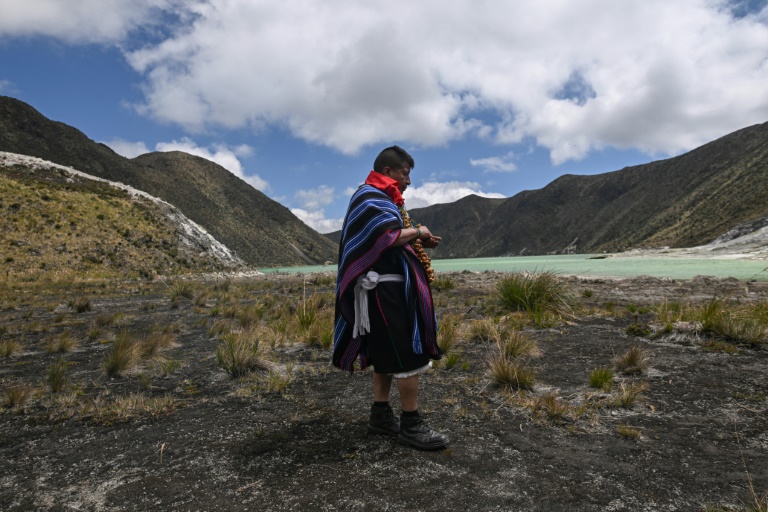In the heart of southwest Colombia, a sacred lake nestled within the crater of a semi-dormant volcano has regained its revered status thanks to the stewardship of Indigenous leaders. Azufral, which soars to 4,070 meters in the western Andes, poses a challenge for those uninvited and unprepared. Only with permission from the governor of the local Indigenous Pastos community can one traverse the path to this picturesque destination. Jorge Arevalo, a member of the Indigenous guard responsible for the lake, emphasizes the need for respect towards the spirits associated with the water. This sacred body of water, known as Laguna Verde, is famed for its vibrant green hues that captivate those who are permitted to make the pilgrimage. A ritual led by a taita, or shaman, prefaces each ascent, during which the climbers pay homage to the spirits of the lake and the natural world that surrounds it. This practice of seeking permission and blessing exemplifies the deep-seated beliefs of the Pastos people in the sanctity of their land.
Historically, Laguna Verde was a hidden gem that garnered increased attention after being featured in Colombian media as a “hidden treasure.” Unfortunately, this exposure led to an overwhelming influx of visitors. Estimates suggest that up to 1,500 tourists flooded the area each day, wreaking havoc on the environment and the serenity of the locale. Reports surfaced of motorbikes tearing up the volcano’s trails, unsanitary conditions with human waste contaminating water sources, and native plant species being trampled by eager foot traffic. The situation prompted the Pastos community to take drastic measures to protect and restore the lake and its surrounding reserve. In September 2017, the Pastos declared a closure of the interior region and the 7,503-hectare area, which received backing from local authorities the following year. The decision not only highlighted the community’s commitment to conservation but also showcased the impact of uncontrolled tourism.
After extensive efforts to clean up the area, the reserve has flourished once more, devoid of trash and human remnants barring established pathways. The Indigenous guards regularly patrol the territory to enforce the access restrictions, demonstrating a deep commitment to ecological preservation. While some unwitting trespassers are met with verbal warnings, the enforcement indicates a strong desire to curb potential damage from tourism. The experience reflects the growing global awareness regarding sustainability, particularly among communities that hold stewardship of ecologically important sites. One Dutch hiker expressed appreciation for the measures taken to protect the pristine environment, recognizing the allure that the lake has while endorsing the need for its conservation.
The management practices of the Pastos community at Laguna Verde are gaining recognition on international platforms, with an opportunity to be highlighted at the UN COP16 biodiversity conference in Cali. Invited by the European Union, the Indigenous guard will partake in discussions surrounding effective sustainable tourism and management of natural resources that are invaluable not only to local culture but also to the health of regional ecosystems. EU ambassador Gilles Bertrand noted that the Pastos’ efforts in preserving this sacred site play a significant role in the broader context of environmental conservation, aiding in maintaining global climate balance. Such recognition validates Indigenous practices and highlights their role as custodians of the land.
Amid ongoing conservation efforts, there exists a palpable tension between preservation and economic opportunity within the Pastos community and the wider Narino department, which is grappling with poverty. The delicate balance of sustainable tourism emerges as a potential avenue for income while safeguarding the integrity of the ecosystem. Diego Fernando Bolanos, the region’s tourism chief, advocates for a carefully managed reopening of Laguna Verde that limits daily visitors to ensure both the preservation of the delicate environment and an opportunity for financial gain. This approach suggests a model through which communities can engage tourists without compromising their cultural or ecological principles.
By emphasizing a commitment to sustainable tourism, the Pastos people demonstrate a profound understanding of their land and its significance. Jorge Arevalo’s ambivalence towards reopening Laguna Verde echoes the sentiments of many in the local community who seek to control the flow of tourists and protect their cultural heritage. The story of Laguna Verde serves as a compelling reminder of the complexities surrounding tourism; it encapsulates the struggles between conservation, cultural integrity, and economic necessity in the face of increasing global interest in remote and awe-inspiring destinations. The saga of this sacred lake, its Indigenous guardians, and the intricate ties to the natural world reflects a broader narrative of reconciliation between modern tourism practices and the traditional wisdom of Indigenous stewardship, paving the way for a more sustainable and respectful index of cultural and natural heritage in Colombia’s diverse ecosystems.

